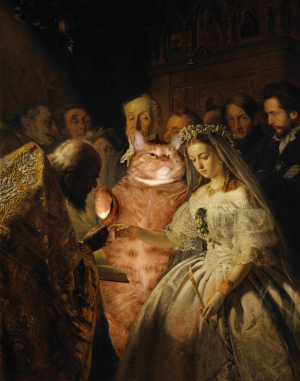
 HEW. It took a long time to get to this post; nearly as long as wedding processions seem when you are playing the organ through 11 bridesmaids.
HEW. It took a long time to get to this post; nearly as long as wedding processions seem when you are playing the organ through 11 bridesmaids.
The Liturgy of the Word in the Nuptial Mass is fairly straightforward. Any of the readings from that ritual Mass section of the Lectionary may be used in their respective places. One point I would ask you to pay attention to, and I can’t believe I even have to say this, is that you should be sure that your chosen readers can actually read. Seriously. Often, this is the role that people are asked to perform when they aren’t quite best-friendy or close-family enough with the bride or groom to become one of the eleventy-six bridesmaids or groomsmen, so they are asked to read instead. Make sure whomever you ask has experience reading at Mass, and that they practice doing so before the Mass. Otherwise, you will end up with the reader who double-clutches during Ephesians 5, or breaks out into giggles during sexy, sexy Tobit.
After the homily, the meat of the wedding ritual comes in. The vows are the sacramental form of Matrimony, so careful attention should be given to this part. While it is not required, I strongly recommend brides and grooms memorizing their vows. This is a solemn promise that you are making for the rest of your life. If you can’t remember what it is, what are you doing? It’s three sentences:
I, Y, take you, X, to be my wife. I promise to be true to you in good times and in bad, in sickness and in health. I will love you and honor you all the days of my life.
(I did that off the top of my head, by the way. 8 years married BOOM.)
There is an option for a different set of vows in the United States, as well.
There is nothing wrong with being assisted by the priest or deacon if you stumble. I think it should be relatively easy to do this from memory, however. The blessing and exchange of rings is even easier:
Y, take this ring as a sign of my love and fidelity, in the name of the Father, and of the Son, and of the Holy Spirit.
That’s it. Those are literally the only lines you have in this part of the rite.
Which brings us to the “Unity Candle.” While this practice has been allowed in many Catholic weddings in recent history, it is not a part of the Catholic Wedding at all. Before you go hog wild in unifying that candle, ask yourself this question: What is this a symbol of?
Is it a symbol of the unity of your families brought about by marriage? That’s not what marriage is. It is a unifying of two individuals.
Is it a symbol of the sacramental promise between the bride and groom? You just exchanged rings for that.
Is it a symbol of the physical unity of the spouses, that “two become one flesh?” You have sex for that. It’s a million times better than lighting a candle.
The Unity Candle isn’t just not a part of the Catholic Wedding; it’s either a false statement, or it’s redundant, or it’s trite. Of course, this might be one of those hills, depending on your parish and liturgical history.
Couples getting married should familiarize themselves with this part of the liturgical celebration more than any other. This is, after all, their part of the liturgy. The bride and the groom are the ministers of the sacrament, and deficiencies due to laziness or lack of preparation are not acceptable. This is the moment you’ve been waiting for. Do it well.
Series by Andrew R. Motyka: “Weddings: Some Practical Advice”
SECOND PART • The Very Beginning, Part 1
THIRD PART • The End Of The Beginning, Part 2
Stay tuned for more additions!
